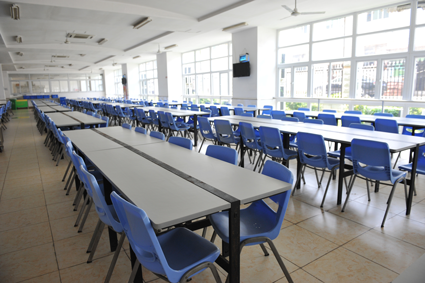
Some of the most challenging areas confronting the designers of HVAC systems for K-12 schools are the high occupant load areas such as Cafeterias, Gymnasiums and Auditoriums. Code dictates a very high occupant load which must then be accounted for in the heating/cooling calculations, but that occupant load also translates into a code-prescribed outside air ventilation rate.
In many cases, the outside air ventilation rate is greater than the calculated airflow for heating and/or cooling. Often, these spaces have a varied occupant load mixing periods of nearly full occupancy with other times of minimal to no occupancy. To minimize the effects of the large quantities of outside air required on the overall energy consumption of the building, we have employed energy recovery and Demand Control Ventilation strategies with great success.
One of the simplest methods to reduce the outside air impact is to employ an energy recovery device inside custom or semi-custom air handling equipment. There are many types of energy recovery devices used by MEP engineers today, but the two most widely applied forms utilize flat plate and wheel heat exchanger technologies.
Flat plate heat exchangers are constructed from thin aluminum sheets, folded in an accordion-like fashion and placed into solid end panels on two sides.
What flat plate heat exchangers do:
Energy recovery wheels are constructed of multiple types of material ranging from thin metal film to desiccant impregnated polymer materials.
What energy recovery wheels do:
A slightly more complex method of reducing the impact of the outside air load is a strategy called Demand Control Ventilation (DCV). This approach can be accomplished with standard air handling equipment, as opposed to the custom or semi-custom energy recovery air handling equipment, which generally makes the entry cost somewhat less than energy recovery. However, unlike energy recovery, there is no possibility to regain any waste heat from the relief/exhaust air streams; this cost savings often negates the lower first cost of the DCV systems.
In a DCV system, the heating and cooling capacity of the equipment is sized to provide the code required minimum outside air ventilation rate, but the equipment is not controlled to provide that volume at all times.
What DCV systems do:
In essence, this strategy works to maintain an environment where the air within the space remains diluted to a programmable CO2 concentration. As CO2 levels rise, it is accepted that occupancy has risen, and therefore a greater quantity of outside air is necessary to meet the ventilation rates associated with those occupants. The outside air damper will continue to modulate open only to the code required minimum position, and will remain there until space CO2 levels begin to decline.
Peter Basso Associates has proven all three of these techniques to be effective in reducing the impact of the large outside air quantities required to satisfy the code requirements of high occupant loads. Each has several benefits, and also some associated complexities. If you would like more information on how any of these systems could be a benefit to you and your facilities, please contact us.
Contact us to learn more about how Peter Basso Associates can use its decades of commissioning, engineering and LEED® expertise to help improve your building's operations and performance.
These Stories on K-12